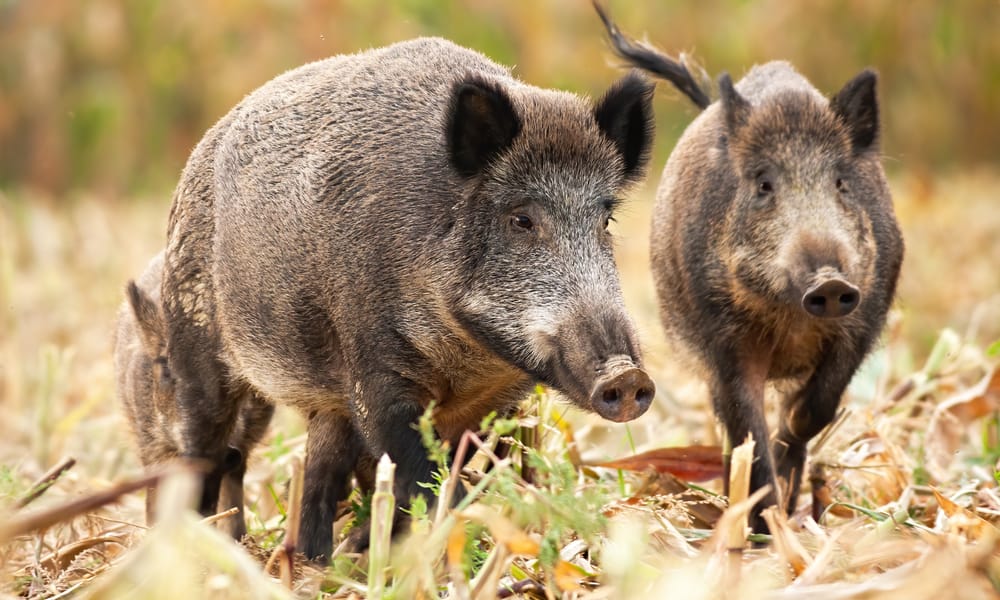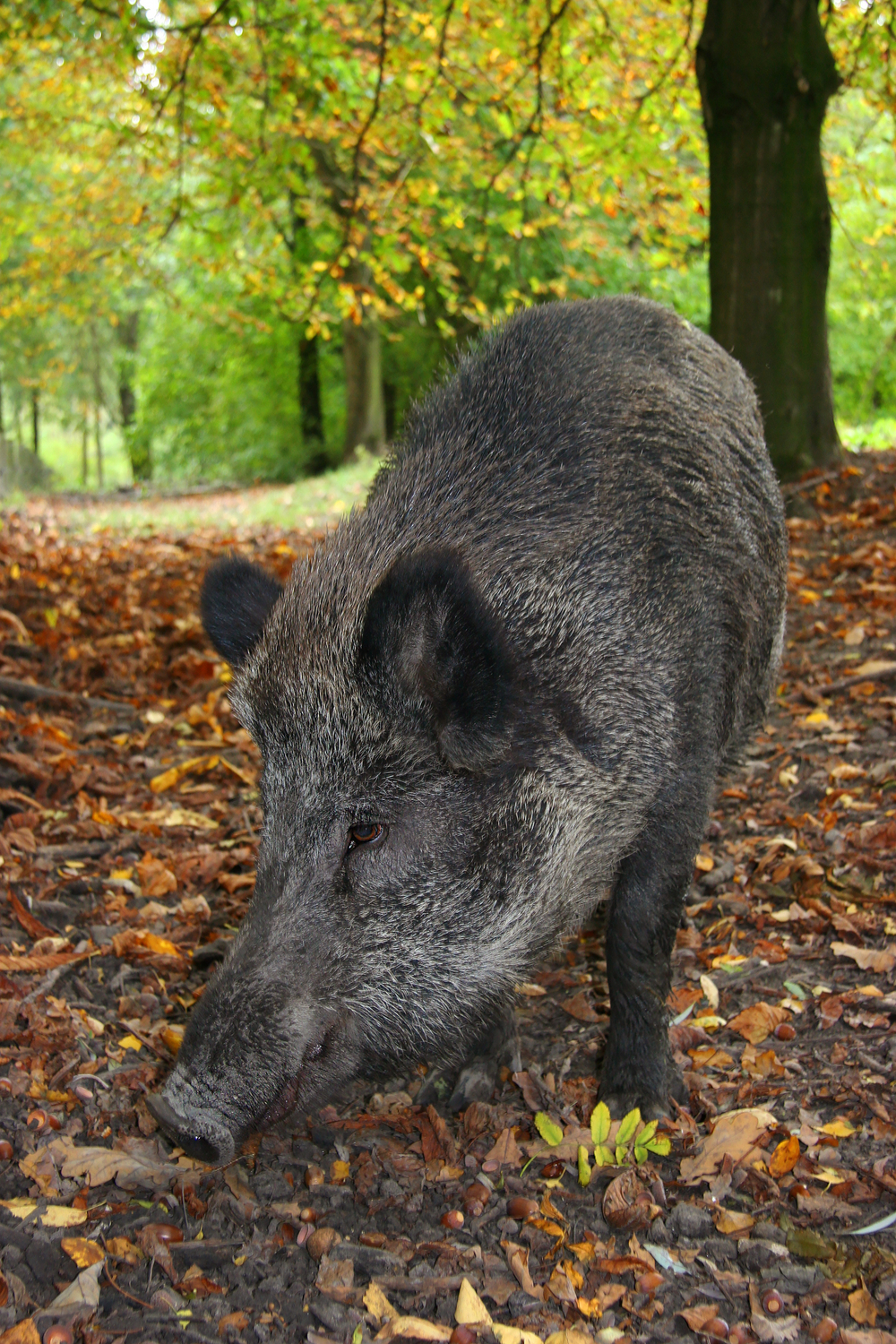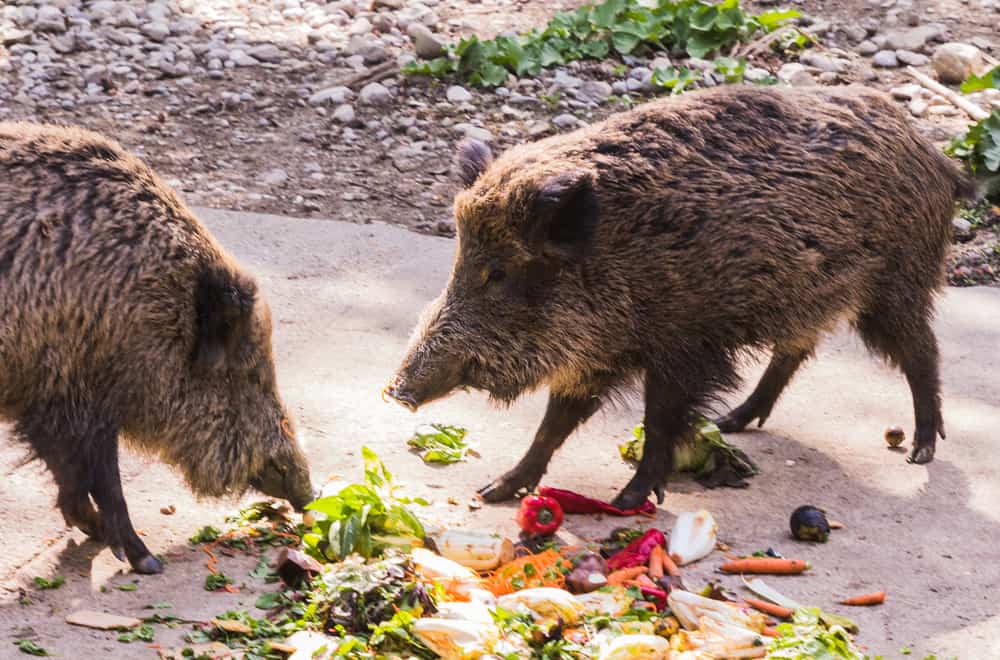Wild boars are animals that live in various European forests, but also in north-west Africa and certain parts of Asia. The experts are not sure how many subspecies are there. According to them, there are between 4 to 25 types of wild boars in the world.
In this article, we will talk about what do wild boars eat, and we will review their common habits.
Wild Boars Habits and biology
There is a lot of interbreeding between wild boars, but biologists claim there are four progenitor species. Given all this mixing, there are numerous differences between animals. However, they are generally similar in terms of size and appearance. What usually sets them apart is their color.
Wild boars have lots of great features and are very adaptable. They can live almost anywhere, eat various foods, and are great swimmers. Although relatively small in stature, the animal can be very territorial and vicious when facing a threat.
We classify these animals as mammals. They have two layers of coat: the first one is a softer undercoat, and the other one is a hard top layer. Wild boars have various colors ranging from black to brown, dark grey, and red. In most cases, their color depends on location and genetics. Although they have very poor eyesight, they rely on smell to detect nearby movement, threats, and potential prey.
These are some of their most common habits:
- These are nocturnal animals. They can sleep up to 12 hours a day. Once they wake up, they will go and forage.
- Males and females are completely different in terms of their social behavior. While females live in groups called sounders, the males are loners. They will meet during the breeding season, but otherwise, they will not have much contact with each other. It is also worth noting that females take care of the young, together with other members of the sounder. This group can have between 6 to 30 individuals and commonly consists of females and their offspring.
- These animals commonly live near mud pools. Wild boars need to bathe in mud as it helps them get rid of the parasite. It also provides protection against the sun and heat.
- During the night, the species rests in their den. They make it by cutting grass and going underneath the earth so that it creates canopies.
- The species can communicate by using chirrups, squeaks, and grunting. Grunts are especially important for warning and during feeding.
What do wild boars eat in the wild?
The species forages for food either during early dawn or late dusk. They utilize strong snout to dig plant material, but they will also eat insects. The species has a strong sense of smell, which is why humans use them to find truffles.
Although omnivorous, the boar’s diet is 90% plant-based. They eat things such as berries, fruits, roots, grass, bulbs, and so on. Given they live in areas with seasonal cycles, they had to adapt to changing environments, so their diet will also change depending on the season.
Here are some of the wild boar’s favorite foods:
- Various nuts and especially acorns
- Various fruits and vegetables
- Mice
- Worms
- Snakes
- Lizards
- Eggs
- Roots, bulbs, tree bark, grass
- Carcasses
The species prefers eating nuts, but it will eat almost anything, depending on the situation. Similar to squirrels, they will gather such food during autumn and store it for winter. If necessary, the animal will also devour carcasses and their own kind. When there isn’t enough food, they will start eating fungi and tree bark. During winter, they will eat bulbs, roots, bracken and might even invade nearby crops.
An average boar has around 110 pounds and needs between 4,000 to 4,500 calories every day. If it’s winter, or it’s a pregnant female, these numbers increase exponentially. It gets most carbohydrates from beechnuts and acorns. These substances are necessary for creating fat reserves for the winter.
In many cultures, people cherish wild boars for their ability to spread seeds. However, this also can lead to some issues. For example, the animal can also spread weed and other invasive plants to crops causing issues to farmers. Wild boars can eat almost any herb, and they are resilient to numerous toxic plants.
Facts about wild boars
Wild boars are one of the most recognizable European wild species. They are especially popular because of their relation to domestic pigs. Here are some of the most interesting and fun facts about the animal:
- Besides being able to snuff truffles, they can smell lots of other substances and foods. In certain countries, police and the military use them for detecting drugs.
- Pigs are one of the most common domestic animals in the Western world. In fact, these animals were among the first ones to be tamed some 6,000 years ago.
- When defending or attacking, wild boars rely on their sharp tusks. They are approximately 3 inches long, and they can cause serious damage to humans and larger animals. It is also worth noting that male boars have much longer tusks. Both sexes have tusks on the lower lip, but the males also have one on the upper lip. They use this upper tusk to sharpen the lower ones.
- Wild boars use snouts as special tools. There are quite lengthy and elastic, allowing the animal to dig through the ground when searching for food. The snouts are a bit different depending on the sex. They also have 44 teeth, which they use to mince bones and other hard matters.
- Certain subspecies have an erect mane on their back, which is why we call them razorback boars. Aside from using it as a coat, their fur has a protective function. Wild boars will ram shoulders into one another when fighting with other males as these sections have thick, strong fur. These fibers are so strong and soft that people used them for toothbrushes in the past. Unfortunately, they often had bacteria and would get damaged quickly.
- Although somewhat solitary species, they have very developed communication skills and tend to be loud in sounders. When they squeal, they can reach 110 decibels, which is louder than the sound that a motorcycle can produce. They also utilize their tail to show other boars and animals how they’re currently feeling. It is a tool that can be used to demonstrate aggression and submissiveness.
- During one reproduction cycle, a female can give birth to four to six young. They create nests from a dense thicket, including moss, leaves, and grass. During the initial weeks, the mother will stay by the piglet’s side.
- Besides their size, piglets have different fur. It is light brown with brown and cream stripes spreading across the back. In a way, these stripes help mothers with weak eyesight to find their offspring. When they reach four months of age, these stripes will slowly disappear, allowing them to camouflage within the surrounding.
- Although piglets will start foraging alone when they’re two months old, they won’t become independent until seven months. At that moment, their fur will change to reddish color. However, the fur will continue changing up until one year of age, when they enter adulthood.
- Although great swimmers and relatively fast, their legs can cause them issues. When there is heavy snow, the animal can easily get stuck. Experts theorize that this is the main reason why wild boars haven’t spread further north during history.
- The species has a very long life span. In the wild, they usually survive for ten years. But a few boars held in captivity made it to 25 years of age.
- Unlike most other species, boars can be dangerous to humans as they are not afraid of them. We often don’t respect them and their territory, which can lead to very nasty wounds. Females with piglets are especially dangerous as they can be extremely protective and don’t have a problem attacking larger animals and people.
- When you look at a wild boar from the side, the animal can seem very intimidating. They are by no means small, and they have a very compact body. Their heads, in particular, can be extremely large especially compared to their bodies.
- Wild boars have major significance in various cultures. Before pigs were widely domesticated, people often hunted them for their meat, bones, and fur. The animal is often showcased in ancient mythologies, including Persian, Greek, and Phoenician. Often, the species was depicted as fierce, unrelenting, and sometimes evil. However, ancient cultures also viewed them as powerful. In certain stories, wild boars are represented as parasitic animals.
Summary
Wild boars are cousins to one of the most common domestic animals, pigs. They don’t see particularly well, by they make it up with a strong sense of smell and hearing.
The animal is very adaptable, and it managed to survive throughout the years despite being hunted by humans. Wild boars are great swimmers and can run very fast. In terms of the diet, they mainly focus on the plants, but they also require insects and certain types of meat.


